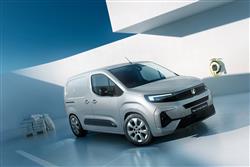Vauxhall Combo Electric - ABC Leasing
AN ELECTRIC BATTERY COMBO(some text hidden)
By Jonathan Crouch
Ten Second Review word count: 53
The improved version of Vauxhall's Combo Electric panel van offers greater range and a bit more visual identity. It continues to share its design with Stellantis Group small LCV cousins but offers the advantages of Vauxhall's huge UK LCV dealer network to companies ready to take their first step into full-electric van ownership.
Background word count: 170
Take up on electric vans has been much lower than that for electric cars. LCV operators aren't swayed by avant-garde design or the prospect of an EV acceleration rush. For many, the switch to electric just looks expensive, with its charging regime inconvenient. Change has to come though and those prepared to make a tentative foray into this new era could do worse than try the van we going to look at here, the improved version of Vauxhall's Combo Electric panel van. Like most vans these days, it's a shared design; you can have basically the same thing badged as a Citroen e-Berlingo, a Peugeot E-Partner, a Fiat E-Doblo or a Toyota Proace City Electric. Company customers though, care less about design semantics and more about service back-up, which is where Vauxhall with its sprawling dealer network ought to have an advantage. So might this enhanced Combo Electric with its improved range, smarter looks and revised cabin be a good first step into a fresh electric era? Let's find out.
Driving Experience word count: 238
Of course, a Combo Electric isn't any different to drive than its E-Partner, e-Berlingo or E-Doblo Stellantis Group EV cousins. Or indeed the Toyota Proace City Electric which also shares this model's basic design and drivetrain. Start up and there's the usual beep as you get the sign that all is ready to pull away; which you do in the default 'Normal' drive mode. The other selectable drive settings are 'Eco' and 'Power'. You'll need the 'Power' mode to unleash the electric motor's full 136hp output, though if you drive like that, you will of course get nowhere near the improved 50kWh battery's enhanced WLTP-rated best driving range figure of up to 205 miles (30 miles further than before). Obviously that'll fall with heavy loads in the back. For day-to-day use, it's better to stick to the 'Normal' mode, which restricts output to 108hp; or possibly around town to 'Eco' mode, though that gives you just 81hp and restricts the climate system. 'Normal' mode should be fine for realistic maximisation of range, particularly if you're proactive with the regenerative braking paddles that have been added behind the steering wheel - there are three settings. As usual with EVs, if you do need performance, it's only a right foot jab away; 62mph from rest occupies 11.2s, but the instant response you get to 30mph makes this LCV feel quicker than that. Overtakes are easy too; 50-75 mph takes 8.9s.
Pictures (High res disabled)

.jpg)
.jpg)
.jpg)
Scoring
Category: Compact Car
| Performance | |
| Handling | |
| Comfort | |
| Space | |
| Styling | |
| Build | |
| Value | |
| Equipment | |
| Economy | 80% |
| Depreciation | 60% |
| Insurance | 70% |
| Total | 65% |